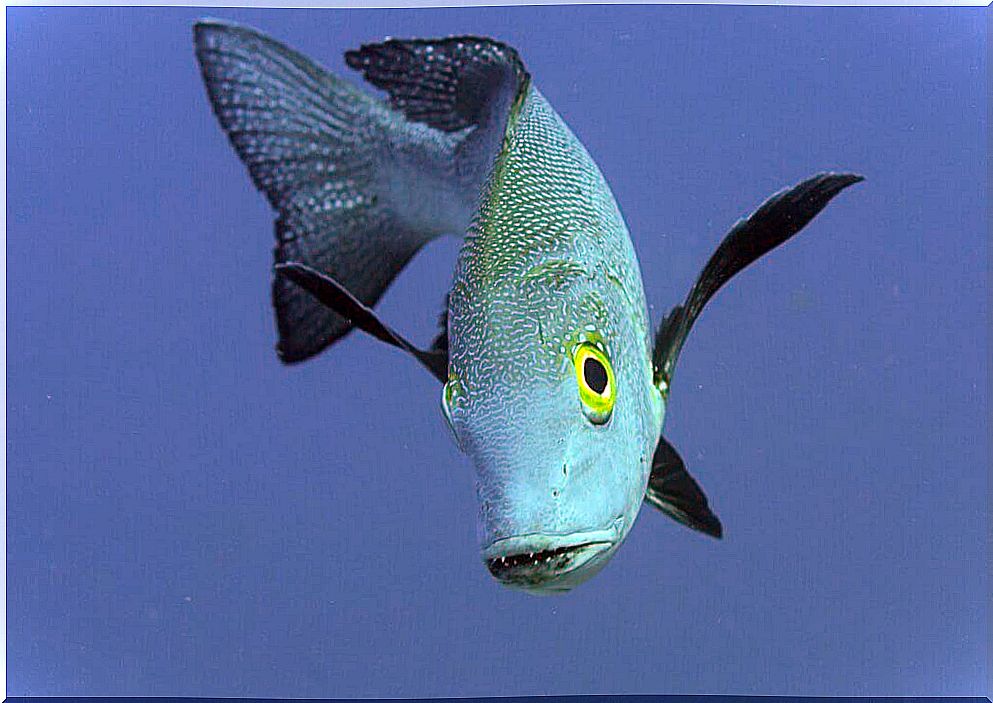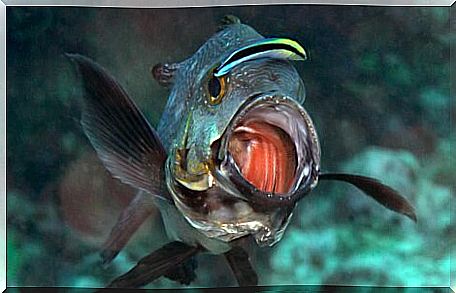Macolor Macularis, The Longest-lived Fish

During 2016, Macolor macularis , the longest-lived fish in the world, was found off the west coast of Australia. On that occasion, a significant number of fish were captured, several of which were over 60 years old.
Would you know which species of fish Macolor macularis is ? Can it be consumed by humans? What scientific interest does it arouse? If you want to know the answer to these and other questions about this long-lived fish, don’t miss what comes next.
Why is Macolor macularis the longest-lived fish?
Scientists are currently investigating the growth and maximum ages of aquatic inhabitants of latitudinal zones. Its aim is to detect and expand your knowledge of coral reef fish and the effect of humans on their habitat – and on the biodiversity that inhabits them.
In 2016, Australian researchers discovered the existence of two of the longest-lived fish on record today. Specifically, the longest-lived belongs to the species Macolor macularis and, at that time, it was estimated that the specimen had about 81 years of life. The other longest-lived fish also found was a specimen of the species Lutjanus bohar, estimated to be 79 years old.
To estimate their age, the reefs to which these species are associated were used as a reference, generally with very long life cycles. As for location, the two fish were found in the Indian Sea in northwestern Australia. Both belonged to tropical species not exploited by man.
- Low mortality rates: These species typically have high life expectancies.
- Low production potential.
- Effective systems applied by authorities: the fact that an animal lives for a long time indicates that it certainly does not figure in an exploratory interest or receive protection from the authorities through laws.

behavior and curiosities
Macolor macularis is not only an interesting fish due to its classification as the “longest fish”. In fact, this species has many other qualities, both physical and physiological. Here are some curious facts about this fish.
1. It was discovered in the early 20th century
Macolor macularis was discovered in 1931 in waters belonging to the South China Sea and also in Japanese waters. After its discovery, this species was included in the order of Perciformes , known as the largest group of vertebrates, with about 40% of the species registered in this huge taxon.
2. The genus Macolor is composed of two species
At the time of its discovery, M. macularis was described from two different species, Macolor macularis and Macolor niger . However, later differences were found between them, based on the different aspects that these species presented, such as the following:
- Number of gills: M. macularis has the highest number of gills, between 110-122, while M. niger has between 87 and 107 gills.
- Anal fin and lateral line: Experts differentiate the two species based on the anal fin and lateral line.
- Dorsal fin : Slightly serrated in M. niger and deeply serrated in M. macularis .
- Pelvic fin : while in M. niger it is rounded and short, in M. macularis it is pointed and long, approaching its anal fin.
- Color Pattern: One way to differentiate both species is to look at the tones of their head. In M. macularis , one can see a yellowish-brown hue with round blue spots, and M. niger has a black to brown color with a reticulate pattern of bluish lines.
- Common name: The species Macolor macularis is commonly known in some places as “midnight snapper” and M. niger is called “black and white snapper”.
3. Your distribution extends
Both species are part of the Lutjanidae family, which includes 109 species of snapper, divided into 17 different genera. In terms of distribution — as well as some species in the family — they are located in Oceania. Specifically, from the Ryukyu Islands to Australia and the Melanesia sub-region.
4. The longest-lived fish is also nocturnal
As with other animals, fish can be classified as diurnal, twilight or nocturnal. This division is performed according to your peaks of activity and rest. Thus, the fish will be diurnal if it sleeps during the night, nocturnal if it sleeps during the day, and twilight if it becomes active after dark.
5. Is part of the region’s diet
Like many other members of his family, the presence of Macolor macularis is common in markets. It is usually appreciated that the product is fresh, as this characteristic conditions its subsequent flavor and taste of the dish.
6. Its conservation status is of little concern
According to the International Union for the Conservation of Nature (IUCN) Red List, the midnight snapper is in the “little concern” range. This means that currently its situation is not of worrying risk, but it cannot lower its guard or negatively influence the species’ habitat.

We can conclude that Macolor macularis is not only the longest-lived fish in the world, it also has many other characteristics. Among them, this species stands out for being a marine fish that lives in Oceania and is an important nutritional resource for the region’s population.









